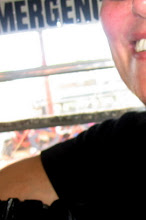
The ruins of the early Mayan Puuc are concentrated around Uxmal, a major site an hour or so south of Merida. Strictly on impulse one day, I decided to take a special bus that would deliver me for a brief stay at four of these ruins in the morning, then deposit me at Uxmal with a couple of hours to explore. I'd been to Uxmal before, so this seemed reasonable.
I had originally planned only to revisit Uxmal, but on the bus ride down I changed my mind. When we parked at Uxmal, instead of getting off the bus, I suddenly stood up and gave the driver the extra money needed for the full route. I still don't know why. I like to take my time when I visit ruins, to wander and sit and try to imagine life there. I don't like to feel rushed and tied to a schedule, but there I was.
At the first site, Labna, we were allowed thirty minutes. The site was small, but I spent two much time at the main building, and not enough exploring the more interesting arch. I just barely made it back to the bus in time. I vowed to do better at X'Lapak.

There, we had only twenty minutes, and that was fine. Or it would have been if I hadn't been the only one who made it back in time. I promised myself I wouldn't push too hard at Sayil. And I didn't, and ended up being one of the last to reach the bus.

Kabah was the last of the small sites on the tour, and should have been the most interesting of the four. It has a famous wall of masks. Or so I hear. The wall of masks is on an upper level, and you have to climb a steep st of fairly high steps to see them. I have arthritis, and I'm heavy, and since I broke my ankle I'm not wildly confident on steps. I really don't like those without railings. As I debated whether there was time for me to give it a shot, I watched a young man in his twenties sidestep down, very carefully. That settled it. It wasn't for me.

Later I heard it was easy to go up, despite the high steps and narrow treads, but the view from the top was very disorienting. The steps were wide, running the length of the plaza, steep, and visually unsettling because there were no sides. Turning sideways eliminated the feeling of being about to pitch forward over a cliff. That explained why everyone seemed to have developed instant arthritis.
The group didn't come back from this part of the trip on time either, so we arrived at Uxmal half an hour late. I was hungry, and I was tired, and I was hot. And I had seen it all before. Why, I thought, should I pay a fairly steep entrance fee to rush around the site. I may have been rushed at the other sites, but the price was right. Two had been free, and the others cost 35 pesos (about two dollars) each.
I declared the race through the ruins over, and had a nice leisurely lunch, a quick walk through the small museum, a look at the shops, and an ice cream. Sitting on one of the slab benches in the visitors center, I remembered that all of these sites had been connected by raised roads, and that they probably had been busy with traders and officials and messangers. Maybe racing through the ruins was the right approach. Maybe it was, in a distorted modern way, a view that the residents had, a quick look as they went about their busy lives.










































